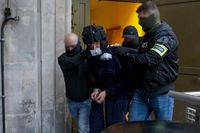A tragic incident unfolded on Wednesday evening at the University of Warsaw, where a 22-year-old law student violently attacked a porter with an axe, leading to a chilling series of events that left one dead and another seriously injured. The attack occurred at approximately 18:36, prompting emergency services to rush to the scene.
According to Piotr Owczarski from the Wojewódzka Stacja Pogotowia Ratunkowego "Meditrans" in Warsaw, when medical teams arrived, they found a woman lying on the sidewalk with numerous axe wounds. "She had extensive injuries to her arms, legs, neck, head, and abdomen. The injuries were so severe that we could not save her life," Owczarski stated.
The victim, a porter at one of the university's buildings, succumbed to her injuries at the scene. A security guard who intervened in the attack was also seriously injured and subsequently transported to the hospital.
Eyewitness accounts paint a surreal picture of the scene. Filip, a student at the university, described the moment he witnessed the attack: "I entered the building and saw a terribly surreal sight— a bloodied woman lying under the Auditorium Maximum building where I have classes. Next to her was a man striking her with an axe." He quickly called emergency services while another student ran to find a security guard. "We then hid back inside the building. Through the window, I saw that the perpetrator was subdued by the police," he added.
Another student, Jakub, remarked on the demeanor of the attacker: "This man looked very young. He offered no resistance and seemed pleased with what he had done. He was not stressed or in shock at all." The suspect, identified as Mieszko R., was taken to the prosecutor's office on Thursday afternoon, where he faces three serious charges: murder with particular cruelty, attempted murder of the university security guard, and desecration of a corpse.
As investigators delve into the background of the suspect, acquaintances describe him as withdrawn and interested in history and militaria, but they insist he was never aggressive towards anyone during their interactions. A criminal profiler, Łukasz Wroński from the Centrum Psychologii Kryminalnej, speculated on the psychological aspects of the crime. "Such behaviors are most common among perpetrators who act out of psychopathological motives or those who have a deep interaction with the victim just before committing murder, leading to a moment of decompensation," Wroński explained. He noted that more information is needed to determine whether there was any prior contact between the perpetrator and the victim, which could indicate emotional motivation.
The shocking nature of this attack has raised significant concerns about security measures at Polish universities. The 39-year-old security guard who rushed to help the porter was unarmed, having no weapon, taser, or even pepper spray at his disposal. He was only able to intervene because a State Protection Service (SOP) officer happened to be on site and managed to subdue the attacker. This incident has sparked questions about the adequacy of safety protocols at educational institutions.
Anna Modzelewska, a spokeswoman for the University of Warsaw, acknowledged the limitations faced by university security personnel. "University security staff at UW do not have the authority to use direct coercive measures. We are in discussions with the Ministry of Science and Higher Education and the Ministry of Interior and Administration regarding potential legal changes to expand the powers of university security guards," she stated.
The gravity of the incident underscores the urgent need for enhanced safety measures on campuses. With security guards lacking the necessary tools to protect themselves and others, there is a growing call for reform. "What powers do they have in cases of threats to life and health? Practically none," Modzelewska added, highlighting the critical gap in safety protocols.
As the investigation continues, the University of Warsaw community grapples with the aftermath of this horrific event. Students and faculty alike are left questioning their safety and the effectiveness of current security measures. The university's administration faces mounting pressure to ensure that such a tragedy does not occur again.
The tragic events of May 8, 2025, serve as a stark reminder of the vulnerabilities present in educational environments and the pressing need for reform in security practices. With the perpetrator now in custody and facing serious charges, the focus will inevitably shift towards ensuring that the safety of students and staff is prioritized in the future.




